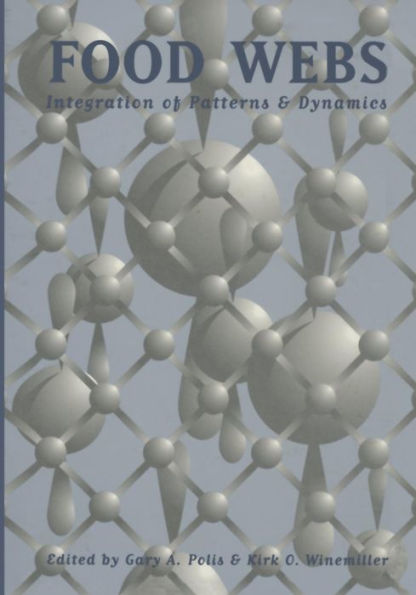5
1

Food Webs: Integration of Patterns & Dynamics
472
by Gary A. Polis, Kirk O. Winemiller
Gary A. Polis

Food Webs: Integration of Patterns & Dynamics
472
by Gary A. Polis, Kirk O. Winemiller
Gary A. Polis
Paperback(Softcover reprint of the original 1st ed. 1996)
$109.99
-
PICK UP IN STORECheck Availability at Nearby Stores
Available within 2 business hours
Related collections and offers
109.99
In Stock
Overview
Reflecting the recent surge of activity in food web research fueled by new empirical data, this authoritative volume successfully spans and integrates the areas of theory, basic empirical research, applications, and resource problems. Written by recognized leaders from various branches of ecological research, this work provides an in-depth treatment of the most recent advances in the field and examines the complexity and variability of food webs through reviews, new research, and syntheses of the major issues in food web research. Food Webs features material on the role of nutrients, detritus and microbes in food webs, indirect effects in food webs, the interaction of productivity and consumption, linking cause and effect in food webs, temporal and spatial scales of food web dynamics, applications of food webs to pest management, fisheries, and ecosystem stress. Three comprehensive chapters synthesize important information on the role of indirect effects, productivity and consumer regulation, and temporal, spatial and life history influences on food webs. In addition, numerous tables, figures, and mathematical equations found nowhere else in related literature are presented in this outstanding work. Food Webs offers researchers and graduate students in various branches of ecology an extensive examination of the subject. Ecologists interested in food webs or community ecology will also find this book an invaluable tool for understanding the current state of knowledge of food web research.

Product Details
| ISBN-13: | 9781461570097 |
|---|---|
| Publisher: | Springer US |
| Publication date: | 03/14/2013 |
| Edition description: | Softcover reprint of the original 1st ed. 1996 |
| Pages: | 472 |
| Product dimensions: | 7.01(w) x 10.00(h) x 0.04(d) |
Table of Contents
Preface— Robert T. Paine; List of contributors— Introduction: Food Webs: What do they tell us about the world?— Kirk O. Winemiller and Gary A. Polis; Section I: Detritus and nutrients: Detritus and nutrients in food webs— Michael J. Vanni and Peter C. DeRuiter; Food webs and nutrient cycling in soils: interactions and positive feedbacks— Janne Bengtsson, Heikki Setala and D.W. Zheng; Energetics of detritivory and microbivory in soil in theory and practice— David C. Coleman; Integrating the microbial loop and the classic food chain into a realistic planktonic food web— Karen G. Porter; Trophic structure and carbon flow dynamics in the pelagic community of a large lake— Ursula Gaedke, Dietmar Straile, and Claudia Pahl-Wostl; Biogeochemistry and trophic ecology: a new food web diagram— Robert W. Sterner, James J. Elser, Thomas H. Chrzanowski, John H. Schampel, and Nicholas B. George; Nutrient transport and recycling by consumers in lake food webs: implications for algal communities— Michael J. Vanni; Food web structure and littoral zone coupling to pelagic trophic cascades— Daniel E. Schindler, Stephen R. Carpenter, Kathryn L. Cottingham, Xi He, James R. Hodgson, James F. Kitchell, and Patricia A. Soranno; Section II: Interaction of productivity and consumption: Interaction of productivity and consumption— Donald L. DeAngelis, Lennart Persson, and Amy D. Rosemond; Dynamics and interactions in food webs with adaptive foragers— Peter A. Abrams; Nonlinear food web models and their responses to increased basal productivity— Roger Arditi and Jerzy Michalski; The relative importance of resource limitation and predator limitation in food chains— Craig W. Osenberg and Gary G. Mittelbach; Indirect effects of herbivores modify predicted effects of resources and consumption on plant biomass— Amy D. Rosemond; Food web dynamics on some small subtropical islands: effects of top and intermediate predators— David A. Spiller and Thomas W. Schoener; Top down from underground? The underappreciated influence of subterranean food webs on aboveground ecology — Donald R. Strong, John L. Maron, and Peter G. Connors; Section III: Causes and Effects: Causes and effects in food webs: do generalities exist?— Janne Bengtsson, and Neo Martinez ; Assessing the relative importance of trophic links in food webs— David G. Raffaelli and Stephen J. Hall; Food webs and perturbation experiments: theory and practice— Peter Yodzis; Energetics and stability in belowground food webs— Peter C. DeRuiter, Anje-Margriet Neutel and John C. Moore; What equilibrium behavior of Lotka-Volterra models does not tell us about food webs — Alan Hastings; Effects of food chain length and omnivory on population dynamics in experimental food webs— Peter J. Morin and Sharon P. Lawler; Structure and dynamics of arctic-subarctic grazing webs in relation to primary productivity— Lauri Oksanen, Tarja Oksanen, Per Ekerholm, Jon Moen, Peter Lundberg, Michael Schneider and Maano Aunapuu; Food webs: from the Lindeman paradigm to a taxonomic general theory of ecology— Steven H. Cousins; Section IV: Temporal and Spatial Scale: Temporal and spatial aspects of food web structure and dynamics— Robert D. Holt; Control of interaction strength in marine benthic communities— Bruce A. Menge, Bryon Daley and P.A. Wheeler; Allochthonous input across habitats, subsidized consumers and apparent trophic cascades: examples from the ocean-land interface— Gary. A. Polis and Stephen D. Hurd; Disturbance and food chain length in rivers— Mary E. Power, Michael S. Parker and J. Timothy Wootton; Factors driving temporal and spatial variation in aquatic floodplain food webs— Kirk O. Winemiller; Food webs in space: an island biogeographic perspective— Robert Holt; Section V: Food webs and applied problems: Food web dynamics and applied problems— Larry B. Crowder, Douglas P. Reagan and Diana W.From the B&N Reads Blog
Page 1 of
